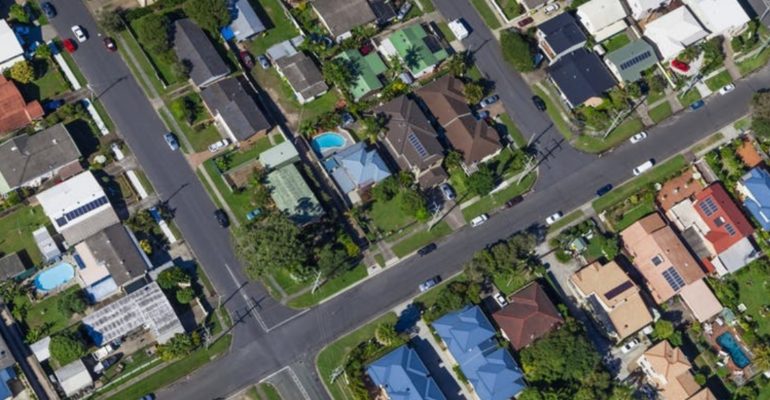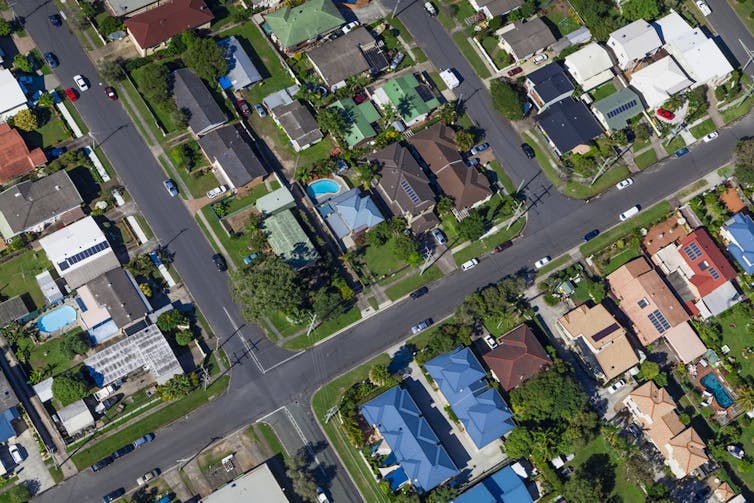

Without medium-density housing being built in the established suburbs – the ‘missing middle’ – the goals of more compact, sustainable and equitable cities won’t be achieved
Australia is increasingly linked to a fast-growing global population. The populations of Sydney and Melbourne are both expected to exceed 8.5 million by 2061. What will Australia’s cities look like then? Will they still be among the world’s lowest-density cities?
Such sprawling cities result in economic (productivity), social (spatial disadvantage) and environmental weaknesses (including a very big ecological footprint). Can our cities transform themselves to become more competitive, sustainable, liveable, resilient and inclusive?
Australian governments at all levels aspire to these goals, but they require multiple transitions. The prospects of success depend on the transformative capacity of four groups of stakeholders: state government, local government, the property development industry, and community residents.
Community capacity for change
Our newly published research has found such capacity is lacking, so transformation on the scale required remains a major challenge. Our research included a survey in Sydney and Melbourne of suburban residents’ attitudes to medium-density living and neighbourhood change – essentially “sounding out” community capacity for change. This article explores some of the findings.
So why do community attitudes in the suburbs matter? The key change involves the form and fabric of Australian cities: from a low-density suburban city to a more compact form characteristic of Europe. This requires regenerative redevelopment: redirecting population and property investment inwards to brownfields and greyfields redevelopment, rather than outwards to greenfields development, and increasing the supply of medium-density housing – the “missing middle”.
Unlike greenfields and brownfields, however, greyfields are occupied. More intensive urban infill represents a challenge to residents of established suburbs to share their higher-amenity, low-density space. And elected local councillors tend to align with their residents’ resistance to “overdevelopment” and changes in “neighbourhood character”.
Are attitudes changing?
In September 2016, the Centre for Urban Transitions surveyed 2,000 Sydney and Melbourne households in established middle-ring suburbs.
Asked “What type of dwelling would you want to live in?”, nearly 60% of residents in both cities favoured a detached house and yard. This is down from 90% in the early 1990s. So, in the space of one generation, attitudes have shifted significantly toward embracing higher-density living.
However, living arrangements extend beyond the dwelling. They include the neighbourhood and wider suburban context. Our survey explored three distinctive living environments:
- a separate dwelling with a garden in a suburb with poor public transport
- a medium-density dwelling with no garden but close to public transport
- a high-rise apartment in the CBD or surrounding areas.
Responses revealed that when location was combined with housing type, this significantly increased preference for medium-density housing when located in established suburbs with good public transport and access to jobs and services. In both Sydney and Melbourne, 46% favoured this. That was the same proportion as preferred a separate dwelling and garden in a car-dependent suburb. Just 8% opted for apartments.
The question is whether these shifts in preference are reflected in residents’ attitudes to higher-density housing in their own neighbourhoods.
The survey found 71% of respondents were “aware of neighbourhood change in their locality”. This figure was identical for renters and property owners.
Fewer than 10% of residents in both cities think such change is a good thing, but almost 40% understand it has to happen. Just over 10% are neutral. Preference for less or no change sits around 45%.
This suggests capacity to accept change is growing, but it is grudging and not strongly endorsed.
The survey’s final stage probed the extent to which property owners contemplating a move were aware of, or open to, options of selling as a consortium of neighbours. While not common, examples are being reported with value uplifts resulting from lot consolidation ranging from 10% to 100%.
One-quarter of Sydney respondents were open to consolidating property for sale with neighbours. This number was even higher (39%) for investment properties.
What needs to be done?
Consolidated lot sales are not part of the business model of most real estate agencies, local government, or property developers.
It’s an area where the property development industry lacks capacity and is still failing to respond to the medium-density urban infill challenge. And state governments are reluctant to extend mid-rise medium-density zones in the big cities beyond designated activity centres and transport corridors.
Supply of well-designed medium-density housing needs to be greatly increased in the well-located, established, low-density, middle-ring suburbs. And it needs to happen at a precinct scale of redevelopment beyond that of knock-down-rebuild. This would enable more innovative, sustainable and aesthetically attractive development.
Infill targets for new housing in Australia’s largest cities range from 65% (Brisbane) to 85% (Adelaide), with Melbourne and Sydney in between. But these targets are not being achieved (not even Perth’s 47%). Greenfield development is still the main demographic absorber.
The Victorian government’s latest metro strategy introduced a new policy direction to “provide support and guidance for greyfield areas to deliver more housing choice and diversity”. That doesn’t alter many residents of these areas remaining resistant to change.
State and local governments need to introduce new statutory planning instruments and guidelines to enable greyfield precinct redevelopment. These are the focus of research in three Commonwealth Co-operative Research Centres (see here, here and here).
In an urban planning system that remains strongly top-down, local government serves as the main interface with local communities and property developers due to its role in planning approvals. Often this is reflected in local government’s gaming of the state government’s residential zoning schemes to ensure housing is “locked up” in minimal change zones. This effectively indicates that more intensive infill housing should happen “somewhere else” (the NIMBY syndrome).
David Chandler, a leading figure in Australia’s building and construction industry, sums up the challenges:
The capabilities needed to design and build small-scaled medium-density housing projects of three to ten dwellings up to three storeys atop below-grade parking have yet to be developed. If medium-density dwellings of the type described here are to make up a third of the housing landscape, a new marketing platform and delivery model will be required.
If governments are seriously minded to harvest the potential of greyfield sites and the urban middle, they will not only need to bring the community along in support of these more modest densification initiatives, they will need to be proactive in making sure the housing industry has the capabilities to deliver them.
Peter Newton, Research Professor in Sustainable Urbanism, Swinburne University of Technology
This article was originally published on The Conversation. Read the original article.
Published by Redlands2030 – 5 July 2018
Please note: Offensive or off-topic comments will be deleted. If offended by any published comment please email thereporter@redlands2030.net
One Comment
Some commentators support a reduction of population growth in Australia, but only until the building of infrastructure catches up. Overwhelmingly, an increasing population is sought. Most population boosters fixate on an economic theory that enough is never enough, that never-ending economic growth and bigger profits are essential. Simplistically, this requires never-ending population growth.
Recent comments in The Australian newspaper compared the land area and population of Australia with that of the United States, purportedly to show that Australia could sustain a bigger population. Such arguments boggle the mind. The United States has a more favourable climate for agriculture than Australia and vastly more fertile land and greater water supplies. Consequently, it can support a much larger population. Indonesia has much less area than Australia but, likewise, can support more people. In many places Indonesia has fertile topsoil up to seven metres deep. Nowhere does Australia have anything like that. The size of the land mass has no direct correlation with its ability to support a big population. Then there are statements about the need to bring more young people to Australia to pay more taxes to support the aging population. This overlooks that these young people too will age, thereby increasing the number of aged that presumably will require even more young to be brought in; and round and round we go. All of these arguments are merely part of one gigantic Ponzi scheme. Missing is rational analysis of the growth dogma and examination of other options available to meet economic sufficiency and societal well-being, including to support the aging by mandating sufficient superannuation contributions.
Most problems in Australia stem from having too many people, including: the lack of a reliable and affordable national food supply because of the variable climate (the continuing destruction of the natural environment to create more farm land); the depletion of natural fish stocks (the need to import vast quantities of seafood and to build artificial fish farms); the lack of a reliable and affordable water supply to grow food, to drink, and to maintain the environment (the need to build desalination plants, drain rivers, and import bottled water); the increasing pollution of the air, the rivers, and the seas (sediment run-off onto the Great Barrier Reef and oceans becoming plastic sludge); problems with garbage disposal; electricity shortages; and the depletion of non-renewable resources that will become serious in less than 100 years.
Why the rush? Why the need? Australia ranks second in the World on the United Nations “Inequality-adjusted Human Development Index” that combines a country’s average achievements in health, education and income with how those achievements are distributed among the country’s population. Yet, enough is not enough!
A rethink about Australia’s economy is essential. More and more is not possible. The population size of Australia must be constrained to a level that will allow the quality of life of its people to be sustained now and into the foreseeable future, to the best of our ability.
Read my paper at: https://www.scribd.com/document/262028236/Population-Growth-in-Australia